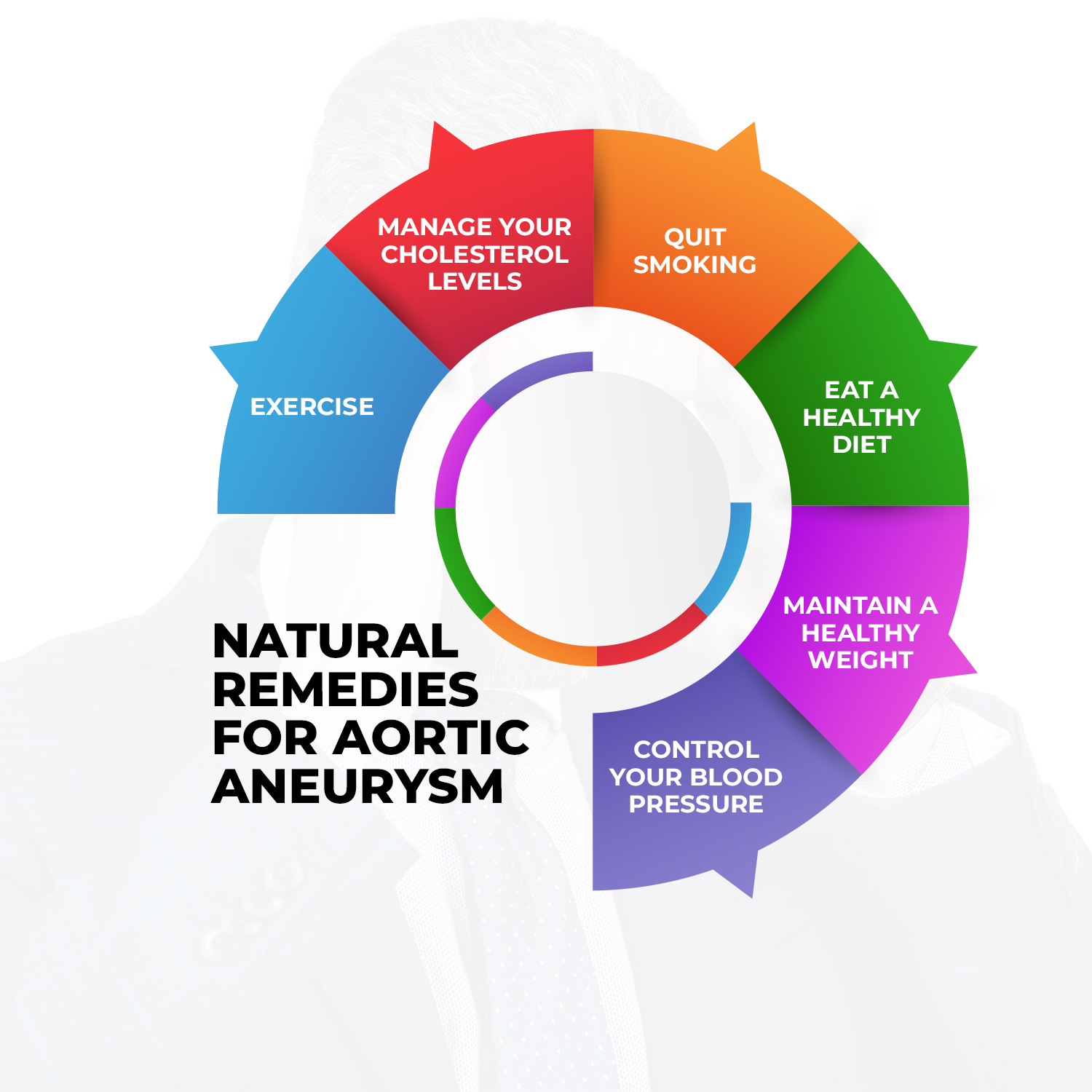


Table of Contents
The aorta is the largest artery in the body. It is responsible for carrying oxygenated blood from the heart to other parts of the body. Over time, due to various factors, the wall of the aorta may become weak and expand. The expansion reduces the capacity of the aorta to be able to house and hold the blood firmly. The pressure of the blood flowing through this weakened area causes a bulging out of the aorta and if proper and immediate care is not taken, it may lead to serious complications. The bulging aorta may burst and blood may spill over the internal organs of the thorax and abdomen. It is therefore important to know how to control them naturally in the comfort of your home.
In this post, you will learn the meaning of aortic aneurysms, the types, causes, symptoms, preventions, and some natural remedies for aortic aneurysms.
What Is Aortic Aneurysm?
An Aortic aneurysm can be defined as the expansion of the largest blood vessel of the body (known as the aorta) as a result of the weakness of the aortic wall.
Types of Aortic Aneurysm
The aorta is located both in the thorax and the abdomen. The part of the aorta that is located in the thorax is known as the thoracic aorta, while the part of the aorta that is located in the abdomen is known as the abdominal aorta. Weakness of the aortic wall can occur in these locations, which is why there are three types of aortic aneurysms. They are:
Thoracic Aortic Aneurysm
A thoracic aneurysm is the expansion or bulging out of the aorta that is located in the thoracic cavity. In the thoracic cavity, an aneurysm can be present in the ascending aorta (which is referred to as the ascending aortic aneurysm), the aortic arch (which is referred to as the aortic arch aneurysm), or the descending aorta (which is referred to as the descending aortic aneurysm).
Abdominal Aortic Aneurysm
An abdominal aneurysm is the expansion or bulging out of the aorta that is located in the abdominal cavity. It is the most common type of Aortic aneurysm because elastin that allows for the normal stretching of the aorta is reduced in the abdomen as compared with the thorax. An abdominal aortic aneurysm is a bulge of about 3.4cm.
Thoracoabdominal Aortic Aneurysm
The aneurysm can be located both in the thoracic cavity and the abdominal cavity. This is why we have the thoracoabdominal aortic aneurysm. It is when there is an expansion or bulging out of the aorta at the border of the thoracic and abdominal cavities.
Causes and Risk Factors of Aortic Aneurysm

Causes and Risk Factors of Aortic Aneurysm
Here are the causes of aortic aneurysms:
Genetic Condition
The genetic condition is one of the risk factors for aortic aneurysms. This is congenital and is not dependent on environmental factors. Some examples of congenital conditions that can lead to aortic aneurysms are Marfan syndrome, Turner syndrome, vascular Ehlers-Danlos, etc.
Atherosclerosis
Atherosclerosis is one of the major causes of aortic aneurysms. It is defined as the build-up of plaque ( cholesterol, fats, etc.) on the arterial wall. If these fatty substances are too much in the body, they are deposited on the arterial wall and clog it. When this happens in the aortic wall, it narrows it and causes pressure which leads to bulging out of the wall known as an aneurysm.
High Blood Pressure
High blood pressure is also another major cause of aortic aneurysm. High blood pressure is when the force of the blood pushing against your artery is high. As the force continues to push against your artery over time, pressure will be generated, and this leads to the weakness of the aortic wall which will cause an aneurysm.
Smoking
Smoking is a major cause of so many cardiovascular problems. Smoking reduces the elasticity of the aortic wall and causes it to be distended. Smoking also contributes majorly to high blood pressure which is also one of the causes of aortic aneurysms. Smoking poses a great risk to an individual’s health.
Infection
An infection that often invades the aorta is a bacterial infection. An infected mass can be found in the heart. This mass is formed from different bacteria, and when they invade the aorta they infect it and cause inflammation of the aorta.
Previous Surgical Procedure
A previous surgical procedure to the aorta may cause an aortic aneurysm if proper measures were not put in place. The surgical procedure is known as an aortic graft. During this process, the graft may be exposed to bacterial infection and this can cause a bulging of the aortic wall.
Old Age
Aging is also one of the risk factors for aortic aneurysms. People that are 65 years and older are at higher risk of developing aortic aneurysms than younger people. This is because as we age, weakness sets in, and this may cause the aorta to lose its elasticity and become expanded.
Trauma
Trauma can also cause an aortic aneurysm. A non-penetrating traumatic experience like falls may cause the expansion of the aortic wall, and this may even occur years after experiencing the trauma. There are however some traumatic experiences that lead to immediate aortic injury. This requires urgent medical attention. Examples of this incident include stabs, gunshots, penetrating vehicle accidents, etc.
Symptoms of Aortic Aneurysm
Initially, the aortic aneurysm doesn’t show any physical symptoms as it grows very slowly. Some will not even show any symptoms throughout their lifetime if it does bulge more. This type of aortic aneurysm can be detected when you go to the hospital for a regular check-up, and appropriate measures will be given to avoid complications. However, when the aortic aneurysm starts to grow bigger, you can start experiencing the following symptoms:
- Backache
- Shortness of breath
- Pain in the thoracic or abdominal cavity
- Weakness
- The feeling of fullness after eating a small portion of food
- Pulsating feeling (as if your heart is beating) in the abdomen
- Cough
Complicated Symptoms of an Aortic Aneurysm include the following:
- Rapid heartbeat
- Sudden sharp pain felt in the chest or abdomen
- Dizziness
- Loss of consciousness
Complications of Aortic Aneurysm
The following are some of the complications of an aortic aneurysm:
Internal Bleeding
Internal bleeding is a very serious complication of an aortic aneurysm. An aortic burst occurs when the aneurysm swells beyond the highest limit and it can no longer hold the blood causing it to rupture. Internal bleeding is a state of a medical emergency. If there is massive internal bleeding, the chances of death are very high.
Heart Attack
An aortic aneurysm can cause a heart attack. When there is an aortic aneurysm, which is often a result of the hardening of the aortic wall, blood may become clogged and form clots. This clot can block the flow of blood to the heart, and if the heart does not receive oxygen from the blood, a heart attack will happen.
Stroke
When the blood supply to the brain is limited because of a thrombus ( when a vessel is blocked by a blood clot) or an embolus (when a vessel is blocked by blood clots and other particles such as cholesterol, fats, etc) that has formed from the aorta, stroke or paralysis can occur.
Natural Remedies For Aortic Aneurysm

6 Powerful Natural Remedies For Aortic Aneurysm
The following are the ways by which aortic aneurysms can be naturally gotten rid of either before they affect a person or after a person has it.
Quit Smoking
As earlier said, smoking reduces the elastin in the aortic wall. This leads to the distention of the wall. It is therefore important to quit smoking. When you quit smoking, you can avoid complications that result from an aortic aneurysm. You should visit your doctor for proper quitting procedures.
Exercise Your Body
Exercising the body cannot be overemphasized. It can be adopted both in the prevention and treatment of an aortic aneurysm. Exercising the body helps to burn unnecessary fats in the aortic wall thereby reducing plagues build-up in the wall. Exercise also helps the heart to pump blood effortlessly by reducing stiffness in the blood vessels. This in turn reduces the blood pressure and helps in the treatment of an aortic aneurysm. Moderate-intensity aerobic exercises are recommended for people with aortic aneurysms. Aerobic exercises include walking, running, cycling, swimming, etc. Any of these should be done for a period of 20-40 minutes per day, 3-4 times a week.
Eat A Healthy Diet
Eating healthily is one of the ways by which aortic aneurysms can be reduced. Food high in calories and fats causes havoc on the wall of the aorta. This causes plaque to build up on these walls and can cause the expansion or bulging out of the aorta. Replace these foods with vegetables, fruits, low-fat dairy products, lean meats, whole grains, etc. You should reduce your intake of carbonated drinks as they contain a high amount of sugar. If possible, avoid them especially if you are managing other risk factors such as diabetes.
Manage Your Cholesterol Levels
Cholesterol is needed in the body but when it’s too much, it creates problems in the body. It is important to cut down and manage your cholesterol levels as they are the major cause of atherosclerosis, and atherosclerosis is the major cause of aortic aneurysms. Bad cholesterol in the body (also known as Low-density lipoprotein) should be replaced with good cholesterol (also known as High-density lipoprotein). Good cholesterol in the body helps to dispose of bad cholesterol present in the body. Some sources of bad cholesterol include chicken skin, butter, fried foods, ice creams, processed meat, etc. Some sources of good cholesterol are foods high in Omega-3 fatty acids e.g salmon, mackerel, etc.
Maintain A Healthy Weight
Maintaining a healthy weight is an efficient way of living a healthy life. When you consume energy and do not burn them, it will store in the body as far, and there will be an increase in the body weight. When a healthy weight is not maintained, the stored fat may clog the aortic wall, and harden it thereby making it lose its elasticity and causing a bulge known as an aneurysm sm. Watching your weight will reduce the impact of being overweight and obese on the aortic aneurysm.
Control Your Blood Pressure
High blood pressure is one of the major risk factors for aortic aneurysms. If you have been diagnosed with an aortic aneurysm and you are also suffering from high blood pressure, it is important to control your blood pressure. Use your medications as when due and keep monitoring your blood pressure ensuring that they don’t go higher than normal. When you do this there will be a reduction in the pressure of the blood against your artery, and weakness will be reduced
Final Thoughts
It is important to combat aortic aneurysm at an early stage to prevent complications, and this cannot be detected if you do not go for routine check-ups. The above measures should help you to reduce or eliminate the symptoms felt. However, if the natural remedies for aortic aneurysms do not improve the symptoms felt, it is important to report to your doctor for further examinations.
Post Disclaimer
The information contained in this post "6 Powerful Natural Remedies For Aortic Aneurysm" is for educational purposes only. Always consult your primary care doctor before using the remedies that are provided. The information is provided by The Hidden Cures and while we do timely, in-depth research on the information that we provide to you, everything stated may not be up to date or accurate from the time it was written.



